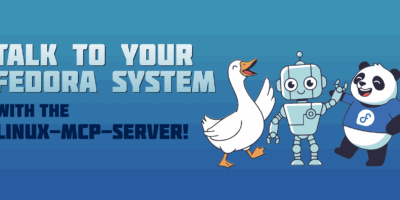As Fedora gears up for the new release of Fedora Linux 35, let’s take a moment to learn about how Fedora assembles each new distribution and what to expect in the upcoming Fedora Linux 35 release. Thanks to Ben for responding to this interview. We previously interviewed Ben as part of “How do you Fedora?” in 2020.
What is the typical release cycle for Fedora? What happens during that release cycle?
Fedora Linux releases every six months — at the end of April and October. Development begins when the previous release branches from Rawhide, which is our rolling development branch. Fedora Linux 35 branched on 10 August, so at that point anything that lands in Rawhide will be for Fedora Linux 36.
We have a Beta release the month before, which allows people to give it a test drive and help us squash remaining bugs. The last few weeks before the Beta and Final releases, we freeze updates, which allows testers to have a stationary target to test against. Only updates that fix release-blocking bugs or have been granted a freeze exception can go into the repo during a freeze.
How does Fedora decide what new features or software to include in each new release?
To a large extent, the people doing the work decide what work to do. We have a Changes process, where members of the community submit plans for what they want to include in an upcoming Fedora Linux release. The plans are published on our development mailing list for a week to allow time for feedback. After that, the Fedora Engineering Steering Committee (FESCo) votes on whether or not to accept the proposal. Most proposals are accepted as-is. Sometimes FESCo asks for changes or clarifications.
FESCo members are elected by community vote, with half of the seats up for reelection every release cycle.
Fedora has spins. What are these, and how do they differ from the main Fedora Linux release?
Fedora produces a lot of variants. The flagship ones are our Editions: Fedora Workstation, Fedora Server, and Fedora IoT. These are targeted at specific, unique use cases. We also have Spins, which feature different desktop environments (like KDE Plasma), and Labs, which target specific use cases (like computational neuroscience).
There are lots of different Fedora spins. What are one or two Fedora spins that folks might be interested in?
I’m partial to the Plasma spin as a long-time KDE Plasma user. We recently added an i3 spin, which features the i3 tiling window manager. That’s been a very popular option.
And we now have two rpm-ostree-based variants to provide an immutable, atomic desktop: Fedora Silverblue (GNOME) and Fedora Kinoite (KDE Plasma).
Fedora Linux 35 comes out soon. What are some of the cool new features in Fedora Linux 35?
I don’t want to call the release boring, but Fedora Linux 35 definitely has fewer big changes compared to the last few releases. There’s a lot of polish and general improvements coming in this release.
The new Fedora Kinoite variant, which features KDE Plasma on an rpm-ostree platform, is exciting. And we now have support for restarting user services when packages upgrade (if the packager opts in to that), which can improve stability when running online updates. A full list of Fedora Linux 35 Changes is available on the wiki.
Fedora is an open source project with a strong community. How can folks contribute to Fedora to help out?
I like to think of Fedora as a mid-sized company, which means we need almost everything a mid-sized company needs. You don’t have to be a coder to contribute to Fedora. We always need documentation writers, testers, marketing, graphic designers, etc. If you can do it, we probably need it! The best way to get involved is to contact Fedora Join. They can help you learn your way around the community and find a good fit.






Tomasz
Hi Jim,
I have question which applies directly to testing.
I have different machines (Surface2, Dell E42(3)00, HP Z Book Core i7 and AMD A10-9700).
There is no problem to use them for testing purposes (hardware and software).
How to apply to the Fedora Testing? Which level of expertise is needed?
Do you use guys any automated testing? Or it should be more like – install and report bugs by authorised Fedora account for bugs?
One/Two evenings per week is no problem for me. But it is more planned or more spontanious? Because I have usually ASAP tasks so I am not regular (based on timeschedule) … too many things are changing in short time.
I am interested to prove that on my equipement everythings works correctly to save time for the future users. In near future I can also buy newer equipment.
Tomasz
P.s.
With version 35 beta I had problem with OpenH264 … it was fixed just before 35 official. I reported this bug.
Gregory Bartholomew
Hi Tomasz. I don’t think there is anything to apply for or subscribe to. I think you want to keep an eye on the Quality Assurance (QA) calendar. For example, if you look back at September 12th through the 19th on that calendar, you will see that that was the test week for kernel 5.14. During those designated days or weeks, you just download the provided operating system image, try it out on your hardware and report the results back to the Fedora Project. Here are the results that people reported back for kernel 5.14: https://testdays.fedoraproject.org/events/119
Tomasz
Gregory, thanks for tips.
I will do during next weekend. As part of preparation to part II of home network.
(What I will not recommend are USB Wireless Dongle Cards by Tplink WN823N… terrible).
DS
Seems best GNOME ever and rocks on Wayland 🙂
Piotr
There are still apps which do not work on Wayland on F35. I really need Onboard (to type signs of the International Phonetic Alphabet) but it doesn’t work on Wayland. Unless there’s another handy way to type IPA on Fedora, I simply can’t use Wayland for my daily work. Unfortunately, Keyman is only available for Ubuntu, so my only choice is between (a) switching to Ubuntu or (b) runig Fedora on X11 as I do.
For me, Fedora Silverblue is the best Linux distro ever, but it fully works only on X11.
Ivan
Hi.
I agree: an Eclipse based app I use doesn’t behave correctly in Wayland/Plasma (until F34 so far), so I am stucked in X11, which doesn’t bother me really, but I guess I am missing something way better. Besides that, everything else works like a charm.
As soon as F35 is released I will migrate, as I’ve been doing since F27.
Great job Fedora Team!
Tomasz
I use Archimate Tool and without this script some menu (actions) not working correctly.
But with script everything is ok.
#!/bin/bash
This is a workaround for Ubuntu/Unify where menus are not displayed in Eclipse based applications.
Refs: https://bugs.launchpad.net/ubuntu/+source/libdbusmenu/+bug/618587
https://bugs.launchpad.net/ubuntu/+source/unity-gtk-module/+bug/1208019
Use this if this problem is experienced.
This is not known to make any difference for other desktops than Unify.
export UBUNTU_MENUPROXY=0
As Wayland is not properly supported by GTK and Eclipse, X11 is used.
export GDK_BACKEND=x11
Launch Archi with any command line options
dir=$(dirname $(readlink -m $0))
$dir/Archi $*
Leslie Satenstein, Montreal,Que,
I don’t like Fedora 35 because everything I tried works. That means, that I have very limited things to learn through troubleshooting, because everything I use, just works, I have no troubleshooting to do.
But, Fedora has been, for the past 15 years, my goto distribution. I use Fedora Gnome and Fedora Deepin.
Thank you to all the developers and contributors, and Quality Assurance experts who have worked to make Fedora 35, the “best polished, well-functioning Linux Distribution” ever. Every new release is a work of art.
M B
I don’t know what kind of work went into touchpad gestures to make it so Mac-like in GNOME 41 but hats off to the team
David
I really like Fedora Plasma, it’s probably the most stable distribution I’ve tried so far. Have had it since 34 was released, it’ll be interesting to see how the update goes : )
Darvond
Right now, I’m the odd duck. I have I3, MATE, NsCDE, WIndowmaker, XFCE, and Sway. So the most mainstream thing I have is XFCE.
I also have TWM, but only as a fallback’s fallback. That one is so old that it just drops the .twmrc right in /home/.
I hope that the FVWM SiG gets it upgraded to 3.0 soon.
Michael Fryman
I love that Fedora 35 picked up enough new features to make a new Dell XPS 17 (new 2021 model 9710) work great, finally. It was only with updates in the last couple weeks (October 2021) that finally fixed the native audio device issues so we have working audio, speakers, headphone, microphone, etc. natively now, without any extra shenanigans required! I believe it was somewhere in kernel 5.14 updates that finally did the trick, after years of folks agonizing over the lack of native support for the Realtek ALC711-CG chips.
shawn
My experience with the KDE spin of F35 is mixed. I have upgraded 3 machines using dnf system-upgrade download –releasever=35 and all 3 of them became near unusable as lots of apps take ages to launch or perform simple tasks like deleting a file. I did a nuke and pave on one of them after and that it seems to work good. I have filed a bug report so they may look into it before it goes into production. But if your not in a position to reinstall from scratch I would give it a week or two from release before pulling the trigger on upgrading to see if any one else has issues.
Richard England
Can you provide the Bugzilla reference for you report?
John F
Looks like it might be https://bugzilla.redhat.com/bugzilla/show_bug.cgi?id=2016691
sridhar
when will fedora 35 final be released?
Gregory Bartholomew
I think it depends on how long it takes to work out the final known blocker bugs. I would keep an eye on the “Current Final Target date” line here: https://fedorapeople.org/groups/schedule/f-35/f-35-key-tasks.html
Shawn
That is it. I just did an update to it.
Bob A
the question is when will 35 be available?.
Piotr
https://fedorapeople.org/groups/schedule/f-35/f-35-key-tasks.html
November 02?
Duncan
Just upgraded smoothly and amazed at the wayland/nvidia marriage. Finally prefer wayland and accept the few irritations and apps playing up compared to X11 stability.
Operating System: Fedora Linux 35
KDE Plasma Version: 5.22.5
KDE Frameworks Version: 5.85.0
Qt Version: 5.15.2
Kernel Version: 5.14.10-300.fc35.x86_64 (64-bit)
Graphics Platform: Wayland
Processors: 4 × Intel® Core™ i5-6500 CPU @ 3.20GHz
Memory: 7.6 GiB of RAM
Graphics Processor: NVIDIA GeForce GT 1030/PCIe/SSE2
Darvond
Upgrade, went smoothly. Only had three minor qt6 packages downgrade, and those were installed mostly to futureproof.
Most exciting upgrades: Wireplumber & SDLcompat. :p
eWill86
Thanks a lot for the spin Fedora LXQT. This OS breathed a second life to my ten years old laptop! 😉
Shawn
Is QT6 supposed to be installed with this upgrade?
segfew
i have trouble with localisation
prawie każda aktualizacja ma problemy z językiem polskim, po aktualizacji system zapomina języka jaki był wczesniej ustawiony. i nie zawsze pomaga ustawienia.
mam teraz jedna maszyne gdzie własnie nie moge ustawic na nowo języka polskiego i jest wszystko po angielsku.
Robert Varga
Coming already?!